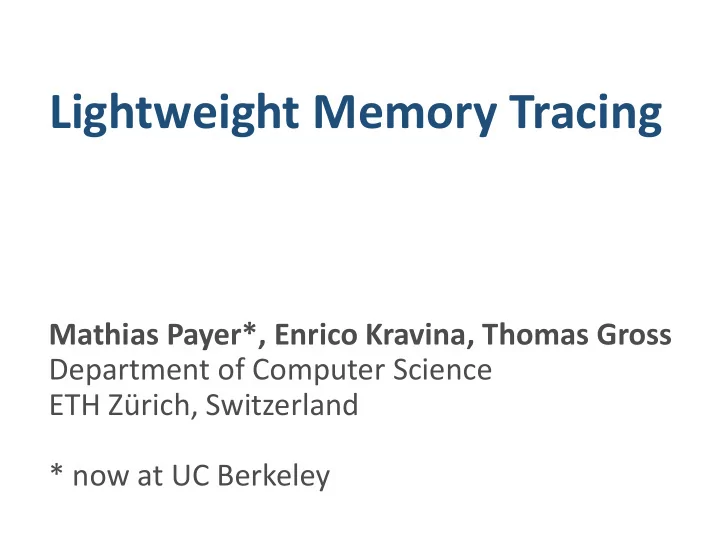

Lightweight Memory Tracing Mathias Payer*, Enrico Kravina, Thomas Gross Department of Computer Science ETH Zürich, Switzerland * now at UC Berkeley
Memory Tracing via Memlets Execute code ( memlets ) for every memory access A memlet inspects a single memory access based on target address , type of memory access, instruction , or prior state Memory tracing enables detailed memory access logs, debugging of memory accesses, security checks, privacy extensions
Memory Tracing by Example Binary translation weaves memlets into executed code memTrace is general, for talk let’s focus on example: • Unlimited watchpoints : check if R/W watchpoint is set addl (%ebx), %eax /* check */ jg bb1 lea (%ebx), %reg jmp bb2 cmpl 0xshadow(%reg), $0x0 jnz handler_92746 /* translated instruction */ addl (%ebx), %eax jg bb1 jmp bb2
Key to Lightweight Memory Tracing Modern CPUs support multiple ISAs: x86/x86_64 • Most programs still 32-bit x86 Cross-ISA binary translation allows the tracer to use additional hardware available in target ISA: • Wider address space: isolation & performance • Additional registers: flexibility & performance
Outline Motivation and Introduction Lightweight Memory Tracing • Requirements • User-defined Memlets • Cross-ISA Binary Translation (BT) • Implementation Evaluation Related Work Conclusion
Tracing Requirements Flexibility Isolation http://blogspot.com Laura Stanyer Performance http://i2.esmas.com http://elie.im
Flexibility through BT Cross-ISA BT Dynamic translator ● Translates individual basic blocks ● Checks branch targets and origins ● Weaves mem emlets into code Original x86 code Translated x64 code 1' 1 Memlets execute 2 2' alongside application 3 3' 4 x64 Kernel
Isolation: Larger Memory Space Application memory Shadow memory Translator memory Translator Stack Translator Code Translator Data Code Cache & Code & Data Code & Data’ Heap’ Stack’ Stack Heap 0x0000’0000 0x0’FFFF’FFFF (4GB) 0x?’FFFF’FFFF (x*4GB) Wider memory space Isolates tracer from application
Key to Low Overhead Fast, efficient binary translation Letting the hardware do most of the work… • use 64-bit addressing (aligned 4GB blocks) • keep state in additional/wider registers • optimize for EFLAGS usage
Implementation memTrace implementation (open source) • Cross-ISA translator • Sample memlets Small, lean implementation Code Comments memTrace 13,800* 3,300 Memlets 150-200 100-200 *4,900 LOC for the translation tables
Outline Motivation and Introduction Lightweight Memory Tracing Evaluation • Unlimited Watchpoints • Safe Memory Allocation Related Work Conclusion
Unlimited Watchpoints Watchpoints trigger on memory reads/writes Memlet checks if read/write watchpoint is set for each memory access addl (%ebx), %eax /* check */ jg bb1 lea (%ebx), %r8 jmp bb2 cmpl 0x100000000(%r8), $0x0 jnz handler_92746 /* translated instruction */ addl (%ebx), %eax jg bb1 jmp bb2
Evaluation Setup SPEC CPU2006 benchmarks evaluated • System: Ubuntu 12.04, GCC 4.6.3 (64bit) • Intel Core i7-2640M @ 2.80GHz, 4GB RAM Four configurations: • Native • Binary translation (BT) only • Memory Tracing • Full Watchpoints
0.5 1.5 2.5 3.5 0 1 2 3 SPEC CPU 2006: Low Perf. Impact 400.perlbench 401.bzip2 Binary Translation 403.gcc 429.mcf 445.gobmp 456.hmmer 458.sjeng 462.libquantum 464.h264ref 471.omnetpp 473.astar 483.xalancbmk Memory Tracing 410.bwaves 416.gamess 433.milc 434.zeusmp 435.gromacs 436.cactusADM 437.leslie3d 444.namd 447.dealII Full Watchpoints 450.soplex 453.povray 454.calculix 459.GemsFDTD 465.tonto 470.lbm 482.sphinx3 Average Geo. Mean
1000 1500 2000 2500 500 0 Memory Overhead: 2x 400.perlbench 401.bzip2 403.gcc 429.mcf 445.gobmk Full Watchpoints [MB] Native Execution [MB] 456.hmmer 458.sjeng 462.libquantum 464.h264ref 471.omnetpp 473.astar 483.xalancbmk 410.bwaves 416.gamess 433.milc 434.zeusmp 435.gromacs Ovhd. [%] Binary Translation [MB] 436.cactusADM 437.leslie3d 444.namd 447.dealII 450.soplex 453.povray 454.calculix 459.GemsFDTD 465.tonto 470.lbm 482.sphinx3 Average Geo. Mean 0% 20% 40% 60% 80% 100% 120% 140% 160%
Safe Memory Allocation Check for use-after-free bugs and heap corruption Intercept calls to malloc and free • Protect metadata of allocated blocks • Check for read/write accesses to freed blocks until they are reused
Outline Motivation and Introduction Lightweight Memory Tracing Evaluation Related Work Conclusion
Related work Valgrind allows high-level transformations on machine code with performance cost (~7x for nullgrind, ~26x for memcheck) GDB/Hardware watchpoints allow a limited set of watchpoints with negligible overhead Limitations of other dynamic tracing systems are (i) limited ISA support, (ii) high overhead, or (iii) limited flexibility
Outline Motivation and Introduction Lightweight Memory Tracing Evaluation Related Work Conclusion
Conclusion memTrace enables lightweight, low-overhead <90% memory inspection for unmodified applications • Use resources of modern CPUs Memlets allow user-configurable checks for each memory access • Flexible framework for memory tracing Source: • http://nebelwelt.net/projects/memTrace/ • https://github.com/gannimo/memTrace
Recommend
More recommend